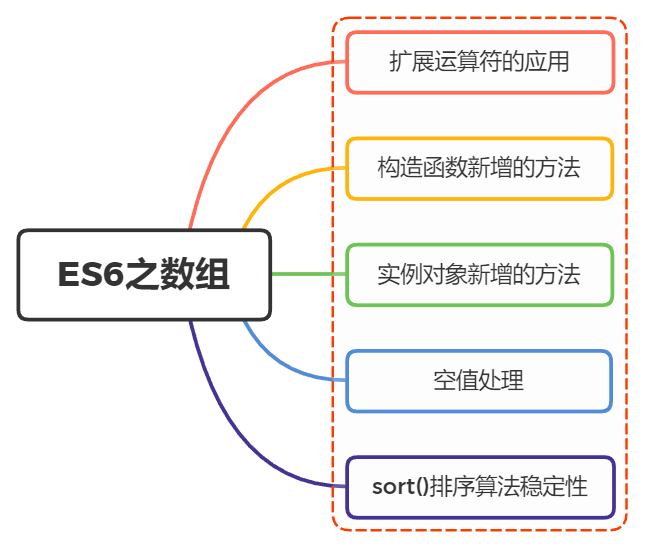面试官:ES6中数组新增了哪些扩展?

一、扩展运算符的应用
ES6通过扩展元素符...,好比 rest 参数的逆运算,将一个数组转为用逗号分隔的参数序列
console.log(...[1, 2, 3]) // 1 2 3 console.log(1, ...[2, 3, 4], 5) // 1 2 3 4 5 [...document.querySelectorAll('div')] // [<div>, <div>, <div>]
主要用于函数调用的时候,将一个数组变为参数序列
function push(array, ...items) { array.push(...items); } function add(x, y) { return x + y; } const numbers = [4, 38]; add(...numbers) // 42
可以将某些数据结构转为数组
[...document.querySelectorAll('div')]
能够更简单实现数组复制
const a1 = [1, 2]; const [...a2] = a1; // [1,2]
数组的合并也更为简洁了
const arr1 = ['a', 'b']; const arr2 = ['c']; const arr3 = ['d', 'e']; [...arr1, ...arr2, ...arr3] // [ 'a', 'b', 'c', 'd', 'e' ]
注意:通过扩展运算符实现的是浅拷贝,修改了引用指向的值,会同步反映到新数组
下面看个例子就清楚多了
const arr1 = ['a', 'b',[1,2]]; const arr2 = ['c']; const arr3 = [...arr1,...arr2] arr[1][0] = 9999 // 修改arr1里面数组成员值 console.log(arr[3]) // 影响到arr3,['a','b',[9999,2],'c']
扩展运算符可以与解构赋值结合起来,用于生成数组
const [first, ...rest] = [1, 2, 3, 4, 5]; first // 1 rest // [2, 3, 4, 5] const [first, ...rest] = []; first // undefined rest // [] const [first, ...rest] = ["foo"]; first // "foo" rest // []
如果将扩展运算符用于数组赋值,只能放在参数的最后一位,否则会报错
const [...butLast, last] = [1, 2, 3, 4, 5]; // 报错 const [first, ...middle, last] = [1, 2, 3, 4, 5]; // 报错
可以将字符串转为真正的数组
[...'hello'] // [ "h", "e", "l", "l", "o" ]
定义了遍历器(Iterator)接口的对象,都可以用扩展运算符转为真正的数组
let nodeList = document.querySelectorAll('div'); let array = [...nodeList]; let map = new Map([ [1, 'one'], [2, 'two'], [3, 'three'], ]); let arr = [...map.keys()]; // [1, 2, 3]
如果对没有 Iterator 接口的对象,使用扩展运算符,将会报错
const obj = {a: 1, b: 2}; let arr = [...obj]; // TypeError: Cannot spread non-iterable object
二、构造函数新增的方法
关于构造函数,数组新增的方法有如下:
- Array.from()
- Array.of()
Array.from()
将两类对象转为真正的数组:类似数组的对象和可遍历(iterable)的对象(包括 ES6 新增的数据结构 Set 和 Map)
let arrayLike = { '0': 'a', '1': 'b', '2': 'c', length: 3 }; let arr2 = Array.from(arrayLike); // ['a', 'b', 'c']
还可以接受第二个参数,用来对每个元素进行处理,将处理后的值放入返回的数组
Array.from([1, 2, 3], (x) => x * x) // [1, 4, 9]
Array.of()
用于将一组值,转换为数组
Array.of(3, 11, 8) // [3,11,8]
没有参数的时候,返回一个空数组
当参数只有一个的时候,实际上是指定数组的长度
参数个数不少于 2 个时,Array()才会返回由参数组成的新数组
Array() // [] Array(3) // [, , ,] Array(3, 11, 8) // [3, 11, 8]
三、实例对象新增的方法
关于数组实例对象新增的方法有如下:
- copyWithin()
- find()、findIndex()
- fill()
- entries(),keys(),values()
- includes()
- flat(),flatMap()
copyWithin()
将指定位置的成员复制到其他位置(会覆盖原有成员),然后返回当前数组
参数如下:
- target(必需):从该位置开始替换数据。如果为负值,表示倒数。
- start(可选):从该位置开始读取数据,默认为 0。如果为负值,表示从末尾开始计算。
- end(可选):到该位置前停止读取数据,默认等于数组长度。如果为负值,表示从末尾开始计算。
[1, 2, 3, 4, 5].copyWithin(0, 3) // 将从 3 号位直到数组结束的成员(4 和 5),复制到从 0 号位开始的位置,结果覆盖了原来的 1 和 2 // [4, 5, 3, 4, 5]
find()、findIndex()
find()用于找出第一个符合条件的数组成员
参数是一个回调函数,接受三个参数依次为当前的值、当前的位置和原数组
[1, 5, 10, 15].find(function(value, index, arr) { return value > 9; }) // 10
findIndex返回第一个符合条件的数组成员的位置,如果所有成员都不符合条件,则返回-1
[1, 5, 10, 15].findIndex(function(value, index, arr) { return value > 9; }) // 2
这两个方法都可以接受第二个参数,用来绑定回调函数的this对象。
function f(v){ return v > this.age; } let person = {name: 'John', age: 20}; [10, 12, 26, 15].find(f, person); // 26
fill()
使用给定值,填充一个数组
['a', 'b', 'c'].fill(7) // [7, 7, 7] new Array(3).fill(7) // [7, 7, 7]
还可以接受第二个和第三个参数,用于指定填充的起始位置和结束位置
['a', 'b', 'c'].fill(7, 1, 2) // ['a', 7, 'c']
注意,如果填充的类型为对象,则是浅拷贝
entries(),keys(),values()
keys()是对键名的遍历、values()是对键值的遍历,entries()是对键值对的遍历
or (let index of ['a', 'b'].keys()) { console.log(index); } // 0 // 1 for (let elem of ['a', 'b'].values()) { console.log(elem); } // 'a' // 'b' for (let [index, elem] of ['a', 'b'].entries()) { console.log(index, elem); } // 0 "a"
includes()
用于判断数组是否包含给定的值
[1, 2, 3].includes(2) // true [1, 2, 3].includes(4) // false [1, 2, NaN].includes(NaN) // true
方法的第二个参数表示搜索的起始位置,默认为0
参数为负数则表示倒数的位置
[1, 2, 3].includes(3, 3); // false [1, 2, 3].includes(3, -1); // true
flat(),flatMap()
将数组扁平化处理,返回一个新数组,对原数据没有影响
[1, 2, [3, 4]].flat() // [1, 2, 3, 4]
flat()默认只会“拉平”一层,如果想要“拉平”多层的嵌套数组,可以将flat()方法的参数写成一个整数,表示想要拉平的层数,默认为1
[1, 2, [3, [4, 5]]].flat() // [1, 2, 3, [4, 5]] [1, 2, [3, [4, 5]]].flat(2) // [1, 2, 3, 4, 5]
flatMap()方法对原数组的每个成员执行一个函数相当于执行Array.prototype.map(),然后对返回值组成的数组执行flat()方法。该方法返回一个新数组,不改变原数组
// 相当于 [[2, 4], [3, 6], [4, 8]].flat() [2, 3, 4].flatMap((x) => [x, x * 2]) // [2, 4, 3, 6, 4, 8]
flatMap()方法还可以有第二个参数,用来绑定遍历函数里面的this
四、数组的空位
数组的空位指,数组的某一个位置没有任何值
ES6 则是明确将空位转为undefined,包括Array.from、扩展运算符、copyWithin()、fill()、entries()、keys()、values()、find()和findIndex()
建议大家在日常书写中,避免出现空位
五、排序稳定性
将sort()默认设置为稳定的排序算法
const arr = [ 'peach', 'straw', 'apple', 'spork' ]; const stableSorting = (s1, s2) => { if (s1[0] < s2[0]) return -1; return 1; }; arr.sort(stableSorting) // ["apple", "peach", "straw", "spork"]
排序结果中,straw在spork的前面,跟原始顺序一致
参考文献
本文作者:毛超颖
本文链接:
版权声明:本博客所有文章除特别声明外,均采用 BY-NC-SA 许可协议。转载请注明出处!
